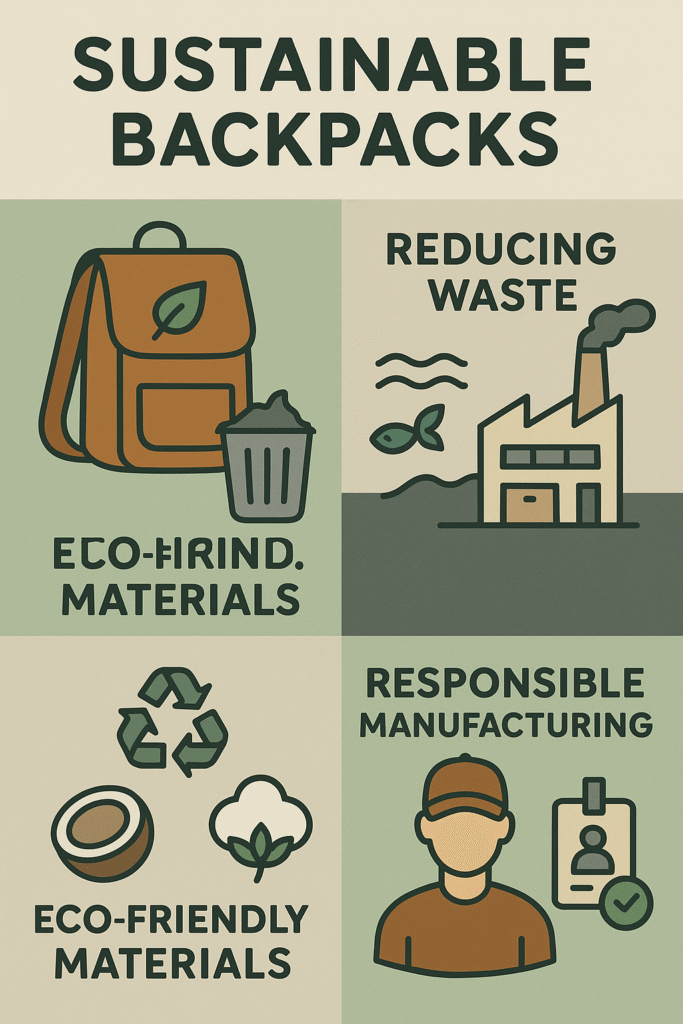The global backpack industry faces a turning point as environmental concerns, labor ethics, and resource efficiency drive change. Mass production has led to excessive waste, microplastic pollution, and unfair working conditions. Governments, brands, and consumers are now shifting towards sustainable backpacks, focusing on ethical sourcing, eco-friendly materials, and responsible manufacturing. By adopting transparent supply chains and innovative materials like RPET and Piñatex, businesses can reduce their environmental footprint. Consumers also play a key role by choosing sustainable backpacks, extending product lifespan, and supporting ethical brands. As the industry evolves, embracing sustainable backpacks is not just a trend but a necessary step toward long-term responsibility.

Environmental Challenges in the Backpack Industry
Textile Waste and Pollution
The U.S. discards over 17 million tons of textile waste annually. About 66% ends up in landfills or incinerators, polluting soil and water with dyes and plastics (EPA 2023). Fast fashion fuels excessive consumption, shortening backpack lifespan and increasing waste.
Microplastics from Synthetic Materials
Nylon and polyester make up 60% of global textiles and release microplastics during washing and decay. These fibers contribute 35% of ocean microplastic pollution (fashion.sustainability-directory.com). Less than 5% of plastic bags get recycled, worsening the issue (theguardian.com). Case Study: A University of Plymouth study found that washing a 100% polyester backpack can release nearly 100,000 microplastic particles in one cycle.
Resource Consumption and Carbon Emissions
Textile production is the second-largest polluting industry worldwide. Dyeing and finishing processes use vast amounts of water—one cotton backpack alone can require thousands of liters. The industry accounts for 10% of global carbon emissions, adding to ecological stress (UNEP 2023).
Labor Ethics: Hidden Exploitation in Supply Chains
Low-Wage Factory Labor and Poor Working Conditions
- South Asia: Bangladesh factory workers earn just $0.30 per hour, far below living wage standards (Fair Wear Foundation 2022).
- Italy’s Prato Factories: Reports of illegal Chinese-operated factories exposed tax evasion, unsafe conditions, and underpaid workers, leading to stricter regulations.
Child Labor and Forced Work Risks
The Fair Labor Association highlighted child labor and toxic chemical exposure in global leather supply chains (fashiondive.com). Italian authorities found some luxury brand factories forcing workers into long shifts with only $2 per hour in wages. Example: Patagonia implemented transparent supply chain policies to prevent child labor and improve ethical labor conditions (Patagonia Sustainable Report 2023).

Government Policies and Industry Reforms
| Region | Sustainability Initiatives |
|---|---|
| U.S. | GAO calls for national textile recycling infrastructure |
| EU | Circular Economy Plan enforces sustainable design standards |
| UK | SCAP promotes low-carbon fabrics and waste reduction |
| Bangladesh | International Accord improves factory fire safety and labor rights |
| Manufacturers | Increasing audits with BSCI, SMETA, and adopting recycled materials (RPET, Piñatex) |
Sustainable Actions for Brands and Consumers
Sustainable Strategies for Backpack Manufacturers
✔ Eco-Friendly Materials: Use RPET, Piñatex, and recycled leather, certified by GRS, OEKO-TEX, and B Corp.
✔ Transparent Supply Chains: Regular audits under BSCI, SMETA, and WSR ensure fair labor practices.
✔ Zero-Waste Production: AI-powered sorting systems help maximize material reuse and minimize waste.
Smart Choices for Eco-Conscious Shoppers
✔ Invest in Durable Backpacks: Prioritize RPET, full-grain leather, and high-quality cotton for longevity.
✔ Support Ethical Brands: Look for companies with transparent sourcing and sustainability certifications.
✔ Reduce Waste, Reuse Bags: Buy fewer, better products and explore repair or rental services like the Turpentine Plan.
The Future of Sustainable Backpacks
The global backpack industry is shifting from mass production to quality-focused sustainability. Policy changes, corporate responsibility, and consumer behavior all influence the transition. AI and innovative materials will drive greater supply chain transparency, waste reduction, and recycling efficiency.
Sustainability is no longer just a trend—it’s a fundamental brand responsibility.



